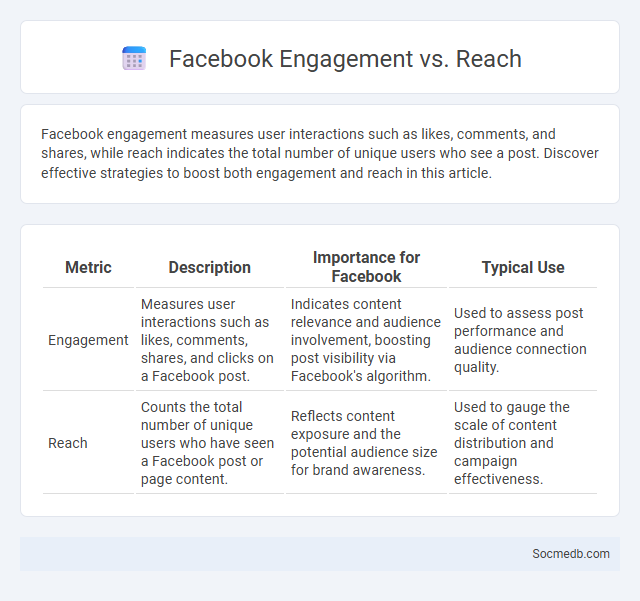
Photo illustration: Facebook Engagement vs Reach
Facebook engagement measures user interactions such as likes, comments, and shares, while reach indicates the total number of unique users who see a post. Discover effective strategies to boost both engagement and reach in this article.
Table of Comparison
| Metric | Description | Importance for Facebook | Typical Use |
|---|---|---|---|
| Engagement | Measures user interactions such as likes, comments, shares, and clicks on a Facebook post. | Indicates content relevance and audience involvement, boosting post visibility via Facebook's algorithm. | Used to assess post performance and audience connection quality. |
| Reach | Counts the total number of unique users who have seen a Facebook post or page content. | Reflects content exposure and the potential audience size for brand awareness. | Used to gauge the scale of content distribution and campaign effectiveness. |
Understanding Facebook Engagement: Definition and Key Metrics
Facebook engagement refers to the interactions users have with content, including likes, comments, shares, and reactions, which indicate audience interest and participation. Key metrics to measure engagement include post engagement rate, reach, click-through rates, and video views, essential for evaluating content performance and audience behavior. Monitoring these metrics helps businesses optimize their Facebook strategies to improve brand visibility and foster community growth.
What Is Facebook Reach? Types and Importance
Facebook reach refers to the total number of unique users who see content from a page or post, encompassing organic, paid, and viral reach types. Organic reach involves users who see content naturally without paid promotion, paid reach covers users reached through ads, and viral reach includes users who see content shared by others. Understanding Facebook reach is crucial for measuring content effectiveness, optimizing marketing strategies, and enhancing audience engagement on the platform.
Engagement vs. Reach: Core Differences Explained
Engagement measures the interactions your content receives, such as likes, comments, and shares, reflecting how actively your audience connects with your posts. Reach indicates the total number of unique users who have seen your content, emphasizing its overall visibility across social media platforms. Understanding the balance between engagement and reach helps you optimize your strategy to foster both audience interaction and brand awareness.
Why Engagement Matters More Than Reach on Facebook
Engagement drives meaningful interactions on Facebook, signaling to the algorithm that Your content resonates with the audience, which boosts visibility and organic reach. Metrics like comments, shares, and reactions indicate active interest and foster community growth, making Your social media presence more impactful. Prioritizing engagement over mere reach ensures that Your posts generate authentic connections and lasting influence.
The Relationship Between Reach and Engagement
Reach indicates the total number of unique users who see your content, while engagement measures how those users actively interact through likes, comments, shares, or clicks. Higher reach increases the opportunity for engagement, but quality content tailored to your audience is essential to convert views into meaningful interactions. Maximizing both reach and engagement requires understanding your audience's preferences and strategically crafting posts that resonate and prompt action.
Strategies to Boost Facebook Engagement
To boost Facebook engagement, prioritize creating high-quality, relevant content tailored to your target audience's interests and behaviors. Utilize interactive features like polls, live videos, and stories to encourage user participation and increase visibility. Consistent posting schedules combined with targeted ads and strategic use of hashtags amplify reach and foster a loyal community.
Factors Affecting Facebook Reach
Facebook reach is influenced by factors such as post engagement, including likes, comments, and shares, which signal content relevance to the algorithm. Timing of your posts plays a critical role, with peak user activity periods increasing visibility. Content type also impacts reach, as videos and images generally perform better than plain text, enhancing Your chances of appearing in followers' feeds.
Best Practices to Balance Reach and Engagement
Maximizing social media impact requires a strategic balance between reach and engagement by tailoring content to target audiences and leveraging platform-specific algorithms. Utilizing diverse formats such as videos, stories, and interactive polls increases user interaction while expanding visibility across networks like Instagram, TikTok, and LinkedIn. Consistent analysis of performance metrics including click-through rates, shares, and comments helps refine content strategies to foster both audience growth and meaningful connections.
Measuring Success: Analyzing Engagement and Reach Metrics
Measuring social media success relies heavily on analyzing engagement metrics such as likes, comments, shares, and click-through rates to gauge how actively your audience interacts with content. Reach metrics, including impressions and unique viewers, provide insights into the breadth of your content exposure across platforms like Facebook, Instagram, and LinkedIn. Understanding these data points empowers you to optimize strategies for increased visibility and meaningful connections with your target audience.
Common Mistakes: Misinterpreting Facebook Engagement and Reach
Misinterpreting Facebook engagement and reach can lead to ineffective social media strategies, as many confuse high engagement rates with wide audience reach. Engagement includes likes, comments, and shares, but a strong engagement score does not always equate to reaching new potential followers beyond Your existing audience. Understanding the distinction between engagement metrics and reach ensures smarter content targeting and more accurate performance analysis on Facebook.
 socmedb.com
socmedb.com